WorkPod
CubeOffice and Armature system
Capital Holding Corporation - 1990 |
refining the navCenter concept |
Virtually
all my architectural work of the 1990s was directed toward
the refinement and actualization of the navCenter
concept and refining the tools and processes by which we design,
build and operate these environments |
| The
floor plan for Capital Holding, drawn in 1990, is
the first layout showing the workPOD™, CubeOffice and Armature™ Systems [link: armature]. Elements of the Armature concept were
incorporated into their navCenter built the following year. As a WorkFurniture system, the CubeOffice was prototyped in 1996, the
workPOD in 1998 and the Armature in 1991, 1997,
1998, 2000 and 2002. With these, we have created an
entire system covering from wall-to-wall, floor-to-ceiling.
An architectural scale, flexible WorkFurniture system that provides easy user controlled adaptability, arrangement and branding options. |
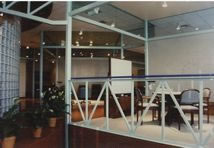 |
| Capital
Holding Center opened in 1991 with built in place
steel Armature system, adjustable WorkWalls, ramps to different floor levels, with multimedia technology and KnowledgeWorker loft area. |
|
| At
the Borgess NavCenter [link: borgess navcenter], the entire 8,000 square feet
was reconfigured (along with sound, video and computer
network) by a small team of Taylor KnowledgeWorkers
in 3 hours. The goal was for end-users to do
this with three simple tools and no “expert”
or “tech” support. As a test of this, in
a 1999 7 Domains Workshop, the participants walked
in to an almost totally deconstructed space. They
were charged with setting it up in two and a half
hours from scratch and to do so in a way that it had never been arranged before. They succeeded. |
|
Captial Holding Radiant Room
1991
|
| First generation POD developed by Paul Lyons installed at the Palo Alto knOwhere Store in 1997. This POD can be configured as a “S” curve with work stations on either side or as a enclosed circle forming an 11 foot “office” space. Wiring runs in a channel at the base so the entire set up can be feed from one source. Each of the sections are built up from a choice of several components and can be moved as a unit then reconnected as an assembly. |
|
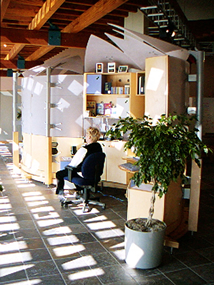 |
| The
surprise with the workPOD was that early users did not
know how to use it. Originally, we built twelve and
employed them in various projects. The response was
divided. Half the people loved the Pod and the other
half disliked it intensely (almost everyone liked
the CubeOffice system). This did not surprise us but
what did was that even those who liked the Pod had
difficulty learning how to use it well. |
| Of
course, I have wanted a POD since I first developed
the concept so I took advantage of this situation
to make one at the Palo Alto knOwhere Store my home.
I was, for over three years, a working Guinea
Pig [link: matt’s workspace at knOwhere] for POD use and research. |
| In
recent years the general acceptance of the Pod has
grown. It is very popular now the big issue being
affordability with the Paul Lyon’s version. The
new Blackburn Pod (2002) will cost about half a much. It
also accomplishes our goal of rolling as a single
unit. As it is built from CubeOffice components it
fits well within the entire system and production
schedules. The completion of the Vanderbilt project
in mid 2002 actualizes the vision and intent of the
1990 sketch. A 12
year development process from idea to regular
production. |
|
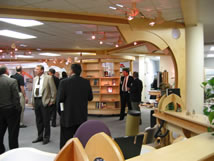 |
In
2002, Bill Blackburn developed a Pod for
the Vanderbilt
Center for Better health based on the CubeOffice system. This is very
close to my original Pod design which I conceived
for Vanguard in 1995 yet much easier to build and configure in a wide variety of ways. The VBCH navCenter was built and installed, mostly from stock components, in less than 30 days.
Click on the graphic (left) for a history of MG Taylor/AI POD development 1990 to 2010. We have 5 PODs we are building today. It is still a low production business and we still have yet to build out a floor based on of this solution. |
|
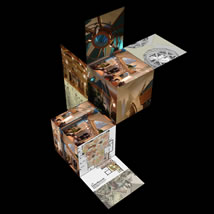 |
|
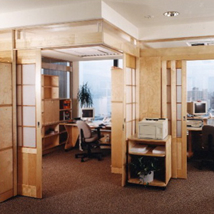 |
| The Cube Office System is based on a two foot by two foot by one foot deep book shelf Module. A double wall provides a three inch space for sliding doors. With in the 2 foot module, a variety of storage unites, closet, pull out secretary unit and work stations are provided. Everything you see can be taken down, moved and reassembled using three tools with no damage to walls, floors or ceilings. |
|
|
CHP
Cube Office System
New York City
1998 |
| The
Cube Office system builds up from a basic 12 by 24
by 24 inch module to complete “office” scale.
The cube components can contain pull down secretaries,
lateral files and storage units. An “office”
can be taken down and erected some place else in a
few hours with out leaving a mark on the existing
built architecture. |
| A
second generation (Foundation II Series) of this system
has been developed and installed in the CGEY Atlanta
ASE environment. |
|
This
version of the CubeOffice, built in 2000, introduces
the Gatling Post which facilitates a greater
use of glass wall which can be configured in
a variety of ways and angles yet easily moved. The Gattling
Post is now a multi-use
component of the system. This application of the system created a an enclosed KnowledgeWorker work area that can be moved anywhere in the space with relative ease. The structure is self supporting and does not depend on the existing building. |
|
 |
| The
CubeOffice System can be used to create stand alone
shelving, workstations, storage systems, wall systems
and PODs. It is flexible, moveable and structurally
stable when constructed. It can be maintained and
moved by the end-user eliminating the issues associated
with scheduling and paying for professionals. The
CubeOffice System is
the backbone of the 1990 concept. |
|
POD
installed at Palo Alto KnOwhere Store in 1997
my work enviornmnet 1999 to 2003
|
To
us, the Pod represents the basic amount of
space and amenity that every KnowledgeWorker
requires. Of course, there are several different ways
to accomplish this utility and function. The Pod is
one. The skin of the Pod can be fabric, wood or Plexiglas
- or sections can be open. This facilitates great
flexibility and adaptability. |
| A
second generation (Foundation II Series 2000) of the
Pod has been developed that allows the system to build
up from one work station (a section) , roll in sections
and as a single unit. The new version is made up of
50% fewer parts than the first and actually docks
with our curved WorkWalls. The
Pods can be arranged in clusters
- or in villages as shown on the Capital Holding layout
and indicated below. By using both sides of the Pod
surfaces, high variety layouts can be accomplished
that achieve remarkable density while at the same
time creating spaces of great Prospect and Refuge
and individual utility. |
| The
Tracery elements of the Armature System act as an visual
integrator, ties the villages together, provides chase-ways
for utilities and one means of circulation. It also
contributes to defining vertical scale. The armature
is composed of moving “plug and play” components
that the users can reconfigure themselves. |
|
ArmatureSystem
- 1999
Showing Foundation II components |
The
Cube, Pod and ArmatureSystems are components that
compose the layout indicated in the 1990
sketch. The layout, itself, can be accomplished
in a variety of ways and adjusted, from time to time,
as required. “Smart” furniture can “know”
certain rules of arrangement and “recommend”
layouts based on Pattern Language values, prior successful
solutions and codes. Great density and utilization
can be accomplished along with a human focussed life-workstyle
- all from affordable, low volume manufactured components.
The technology, means and methods that facilitate
this are part of our Patent and Patent Pending and other IP. |
| The
aramture approach was further developed with the (unbuilt)
Vanguard Development Center in 1995. |
|
Vanguard
Neighborhood Layout - 1995 |
The
metaphor of streets, Alleys, neighborhoods, and so
forth, creates a powerful specification in regards
traffic flow and amenity. The strong architectural
forms of the basic elements and armature allow a variety
of different specific furniture solution-set clusters
and “negative” spaces that make the niches
for sitting areas, support tools, one-off workstations
and small team work areas. Larger group areas are
defined by Cube Office components and fold-out WorkWall
systems in a variety of configurations. Prospect and
refuge along with great variety and flexibility can
be achieved on the horizontal plane. However, this
is not enough. The constant flat, low ceiling - particularly
in large spaces - is not nature to human consciousness.
There is a different psychological sense in looking
up and downward within an architectural space. This
“sense” is important to certain mental states
and, thus, to certain processes.
|
| For
years we have encourged clients to develop the vertical
space of their environments. There are many reasons [link: vertical space] to do this. There are, also, several obstacles to
it: codes, the limits of existing building structures,
the perception that this costs more - the overwhelming
paradigm of 8 to 10 feet ceilings as the “norm.”
We accomplished significant vertical movement with
the Orlando Management Center - 1985 (ceiling changes
and floor platforms), AEDC - 1992 (ceiling changes
and floor platforms) and the Palo Alto KnOwhere Store
- 1997 (ceiling changes, second floor balconies and
skylights). However, the most comprehensive use of
vertical space was the 11,000 square foot Capital
Holding project - 1992 (second level KnowledgeWorker
and tecnology work-deck). Note: this was surpassed in 2007 with the Unicredit project in Turin, Itally [link: unicredit tour]. |
|
|
Orlando
Management Center built 1985 |
This
Center was in continuous use for 14 years. It
has served three different “owners,” the
Acacia Group, MG Taylor and, now, CNL. The flexibility
and adaptability built-in to its layout has allowed
it to accomplish three divergent missions without
requiring modification. While capital intensive when
first built, its durability and adaptive utility has
netted a life cycle cost lower than conventional construction.
|
Most
of the 6,000 square feet is open and adaptable - four
large areas flow into one another or each can be closed
individually or all at once. The three level ceiling
and light coves accomplish three things: small areas
are defined as part of the larger space (so that “place”
is maintained with 6 or 60 in the space); the ceiling
is free of the usual clutter and therefore “reads”
as an active architectural element; and, the HVAC
is delivered from within the coves and does not blow
on people in the space. |
|
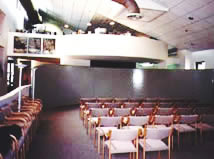 |
| AEDC
Gossic Leadership Center built 1992. Jerry Headly, Design Development and Architect
of Record. This was without question the most productive navCenter ever built in terms of organizational transformation and economic results. |
|
| This
environment was built for the Air Force provided
over 100 DesignShops for the Air Force, NASA, the Aerospace
community, Universities, local businesses and other
members of AEDC’s ValueWeb within the first 30 months of operation. The balcony above the
Radian Room is the KnowledgeWorker work-loft. |
|
Palo
Alto KnOwhere Store built 1997 viewed from the second
level incubation Loft. The knOwhere Stores incorporated retailing, event environments , business incubation, research and the MG Taylor corporate offices. They operated between 1996 and 2003.
Work
under way at the two story high opening dome at the Palo Alto
knOwhere Store center point. The entire front wall of the PA store opened up and so did the dome. This provide natural ventilation which reduced the need for heating and cooling in the temperate Northern California environment even in the center of a city. |
|
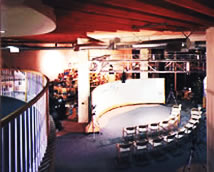 |
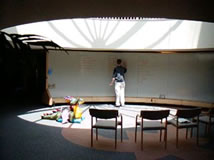 |
| These
views clearly illustrate the power of vertical spaces.
This kind of vantage point cannot be accomplished any
other way. Sadly, it is too often missing in contemporary
architecture. Note the technology
armature over the Radiant Room. It allows for a
variety of setups and the space can be set to comfortably
accommodate 10 to a 100 people. |
The
dome cost $20,000 and was considered a great expense
at the time. This will be about 100 dollars a month
over the period of the lease. This simple “trick”
of curved forms, low, medium and high ceilings, with
the play of natural light - all interacting with appropriate
dynamic rhythm - creates a space that draws people
like a magnet. This area acts as the “center”
of the 20,000 square foot space and turns what otherwise
would have been a low, dark environment into a dynamic,
exciting place to be. The dome with the first and
second floor ceiling collars added less than one-half
a percent to the cost of the project - netting a high
architectural return on investment. |
|
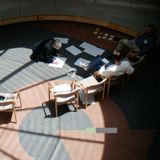 |
| View
from the knOwhere balcony under the dome to the first floor area. These spaces, on both levels, became the most popular in the environment and most spontaneous in their use. Even thought this was the most public place in the 20,000 square foot building, it was the first place people chose to do their intimate team work. |
|
Budgets
come and go - buildings last a long time. This building
is forever altered and now has a value many times
the investment. Spending money on “features”
will not necessarily do this. The treatment has to
be based on intrinsic human values and the way that
people interact with space. It has to support the
processes that take place within the environment. |
In
a world that increasingly builds bland environments
lacking identity, brand and “sense of place,”
people respond strongly and positively to strong architectural
armatures, the use of natural light, fresh air as
the weather allows (more often that supposed) and
carefully selected high quality materials. This does
not have to be expensive. The Palo Alto lease, including
lease hold improvements and interior furnishings, was
under $30 a square foot per year in a real estate
market that had less than 1% vacancy at the time
of remodeling, and typically rented undeveloped, unfurnished
space for more than this. |
| The Capital Holding project also involved
extensive level changes. Built on the first floor of
a traditional building a two story space was created
by going down five feet, opening the ceiling to the
second floor concrete slab and building a loft in-between. |
|
| Capital
Holding navCenter built in 1992. The view is
from the 12 foot wide by 80 foot long KnowledgeWorker Loft area, looking down into several work rooms and two Radiant Rooms. |
|
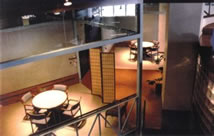 |
| This
created a variety of different spaces in what otherwise
would have been a uniformly dull environment. The
schema actually build a “building” within
a building and allowed a progression of incremental
environs as users moved in and down from the traditional
areas surrounding it. While built in a corporate headquarters,
and while being sensitive to the traditional detailing
and materials (which were brought into the space),
the navCenter “felt” like an off
site experience and a world of it’s own. |
The
Capital Holding steel structure created an armature
which acted as a conduit for electrical, LAN, multimedia
and phone lines - and, supported the the KnowledgeWorkers
deck from which the above photo was taken. The WorkWalls
could be moved from one side to another - along with
all lines - allowing the Break Out/Office space to
open to another area of the Center. It was with the
Orlando Management Center and this project that we
laid the foundations for our technology and wiring
strategies. |
| Throughout
the 90’s, considerable technology integration
was accomplished. Video, audio, computer, phone, LAN
lines were developed into an adaptable “plug
and play” system allowing multimedia capture,
production and playback to become a real-time, integral
part of the work process. |
| The
Borgess NavCenter has Foundation 2 WorkWalls and Cubes
with detachable, rolling “power poles” that
“plug and play” with the wiring above, In
July (1999) just a few weeks after installation, the
KnowledgeWorker staff reconfigured the entire 8,000
square feet space - including A/V, power and LAN lines
- in 3 hours. |
|
The
Borgess insall - May 1999
|
The
next stage of this [link: technology
integration] process involves building computer
and multimedia technology into the WorkFurniture,
establishing Center-to-Center RemoteCollaboration and RemotePresense, and developing the first generation
of “smarts” into the system components themselves.
This work is presently very high on AI’s agenda
and is key to several aspects of our Patent and Patents
Pending.
Most
of the basic ideas that were put into product
during the 90s came from my 60s, 70s, and 80s thinking. We built more, however, in this last decade
than all the others before it. This allowed us a faster,
more iterative, rapid prototyping process. The 2001
and 2002 installations became mature expressions of
these ideas.
Even so, in the 1990s, we are just getting
to the level of component design and manufacture that
we envisioned when we started. |
|
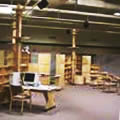 |
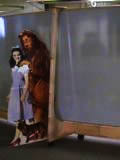 |
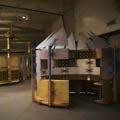 |
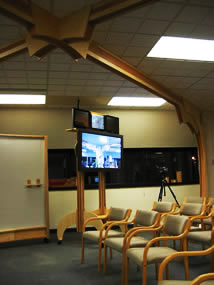 |
| The
2002 Vanderbilt project moved further along the
technology integration path by employing plug-and-play
power poles, which connect to a number of bundled wire whips in the ceiling, and rolling monitor stands based on
the Gatling Post system. This way a large foot print can be arranged in many different ways and equipment connected quickly without extensive rewiring. The floor is left completely free of plugs which interfere with rolling WorkWalls and furniture. |
|
The
level of component capability, that we are able to
deliver today, allows a utilization of space
and level of knowledge “manufacture” than
can not be achieved without it. We are now able to produce an environment
that utilizes Pattern Language principles, serves
the full venue of individual, team and large group
collaboration functions, provides greater personal
space to each KnowledgeWorker than other systems, and overall, achieves greater space utilization
than standard layouts using existing manufactured
components.This
is not an accident but the result of a decade of progressive
projects that integrated design and building with operations. All
this can now be done at competitive costs and in a
radically reduced design-to-move-in time frame. This
cannot be accomplished by design - or even manufacturing
- alone. While there are issues related to the design of architecture - this is not the major problem. The
furniture manufactures are capable of far more progressive
designs than the present market will buy. Clients
and customers want more but maintain a buying-system
that makes the creation of quality workspaces almost
impossible. The total system and method by
which this work is done is the “problem”
- I discovered this upon my entry [link: 1956] into architecture. I have devoted most of my years
of work since then to discovering - and inventing - a way that consistently produces another kind of
result. |
|
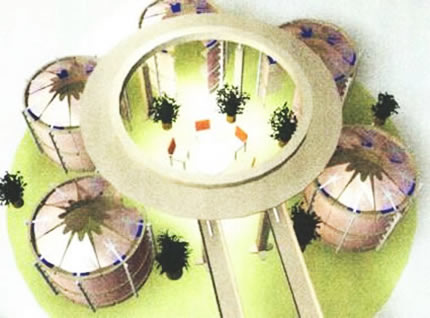 |
AI
PODcluster - ArmatureSystem - 1999 |
Getting
to this “point of beginning” took 20
plus years since what is now MG Taylor was formed.
Every step along the way was funded by a real client
solving a real problem. Every piece and component
went into a work environment dedicated in some way
to creativity/collaboration augmentation. The design team that did this
work has been small. I started the process alone and
was joined by Langdon Morris in the late 70s and again
in the early 90s, and then the current members: Bill
Blackburn in the early 80s and who operated AI
[link: ai] 1992 to 2002 and still designs for us, Gunner Kaersvang (1995-1999),
Paul Lyons 1997- 2002). On the design-detailing
and production end, Bryan Ross since 1987 becoming
full-time manager of the AI production facility
starting, 1998 to 2005. As
small as AI is, it has one of the most comprehensive,
and integrated, lines of work furniture solutions
and design services on the market today. And,
it sells more of this new kind of furniture
than many of the large manufactures. As we proceed
along this path, we will build an integrated design/build/deploy-use
supply chain that is deeply embedded in our larger enterprise [link: mgt valueweb]. |
| When we started MG Taylor there were no components that did what we needed - not on the utility
level nor on the aesthetic level. More importantly,
however, was our need to accomplish - through direct experience - the close connection between design-build-use [link: dbu model].
This is necessary for getting complex product design
and intimate market fit. Because of our ability to
integrate “lust-to-dust” we have been able
to field solutions that multi-billion dollar organizations
have failed to match. Lean production is useful, but it is Lean design/build that is necessary for true innovation. We have not
been able, yet, to do this at any great scale. To
do this we will have to partner with many new, large
and small, ValueWeb [link: valueweb model] members that have capabilities and core-competencies
that we do not. This, however, is consistent with
the Network Economy concept and our own organizational strategy. |
We
are just beginning to see - in this newly emerging
postindustrial, global economy - this kind of linkage
in ValueWebs [link: valueweb architecture] and supply chains. Product improvement is both user-driven and “pushed” by a strong producer
vision. Batch production is giving way to lean,
mass-customization methods allowing for rapid development
and evolution of products and services. The distinction
between products and services is blurring. Design
wins as we can see with the i-Mac, TT and Mini. Making
things and delivering them to a market is the best
way to design. This is employing the 4
Step Recreation Model [link: 4 step] and 3
Cat [link: 3 cat] Models as an OS for a complex ValueWeb.
It involves, for us, using our product/service offerings
as the factory for making them. We are intimately
involved in the entire design,
build use cycle. |
My
design work of the 90s was not just about the “what”
- the product. It was about putting in place an “engine”
of creation that could build the environments we wanted
- which themselves, were “engines of creation.”
This was, and still is, a bootstrap process. Multiple
iterations to make the tool to refine the tool to
make the tool. The
decade of the 90s has come and gone. The work we now
have in progress will accomplish many of the elements
indicated in the Capital Holding sketch. [link: ch sketch] I do not see this work as the “end” - I
see it as a minimum foundation for an effective future
work environment. In reality, we are just getting
in place many elements that should have been ubiquitous in the work environment long ago [link: reworking the workplace]. |
|
Joseki
Offices, June 2002, were hand built on site by a team of students from SFIA. A mundane space was turned into a flexible environmnet expressive of the Joseki brand.
[link: future link] |
|
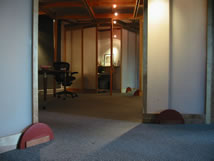 |
When
a new position is created, it acts as a meme [link: what is meme].
This “sets” the game, within which, all
the variations are played out until a new game is
created. The “office” - the workplace -
is in the process of being recreated. Which concept
of “office” gets on the “increasing
returns” slope involves a critical competition.
A competition of ideas, of mental bandwidth of decisional
maker’s attention. It is not the money issue
that matters so much as the total set of consequences
that flows from the choices made and what is consequently
built. How people think and work frames the range
of solutions that they can see and work on. This in
turn establishes the quality of what
we do as a
species [link: a future by design not default]. |
|
Matt
Taylor
Palo Alto
February 20, 1999
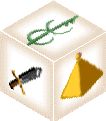
SolutionBox
voice of this document:
BUILD • TACTICS • EVALUATE
|
click on graphic for explanation of SolutionBox |
posted:
February 21, 1999
revised:
October 15, 2010
• 20000603.905342.mt • 20001101.768821.mt •
• 20010204.569812.mt • 20020612.640091.mt •
•
20020617.666622.mt
• 20020619.123400.mt •
• 20101015.211209.mt •
(note:
this document is about 98% finished)
Aspects
of the system and method described are Patented and Patent
Pending.
Copyright©
Matt Taylor 1999, 2000, 2001, 2010 , 2002 |
|
|